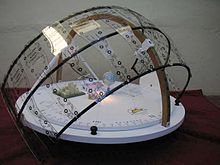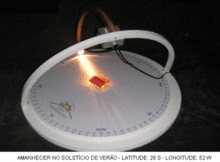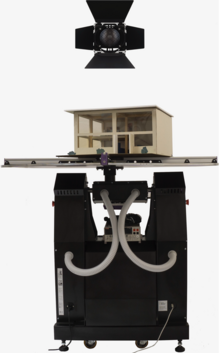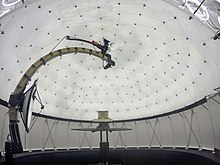
Sunlight is a portion of the electromagnetic radiation given off by the Sun, in particular infrared, visible, and ultraviolet light. On Earth, sunlight is scattered and filtered through Earth's atmosphere as daylight when the Sun is above the horizon. When direct solar radiation is not blocked by clouds, it is experienced as sunshine, a combination of bright light and radiant heat (Atmospheric). When blocked by clouds or reflected off other objects, sunlight is diffused. Sources estimate a global average of between 164 watts to 340 watts per square meter over a 24-hour day; this figure is estimated by NASA to be about a quarter of Earth's average total solar irradiance.

In passive solar building design, windows, walls, and floors are made to collect, store, reflect, and distribute solar energy, in the form of heat in the winter and reject solar heat in the summer. This is called passive solar design because, unlike active solar heating systems, it does not involve the use of mechanical and electrical devices.

Daylighting is the practice of placing windows, skylights, other openings, and reflective surfaces so that direct or indirect sunlight can provide effective internal lighting. Particular attention is given to daylighting while designing a building when the aim is to maximize visual comfort or to reduce energy use. Energy savings can be achieved from the reduced use of artificial (electric) lighting or from passive solar heating. Artificial lighting energy use can be reduced by simply installing fewer electric lights where daylight is present or by automatically dimming or switching off electric lights in response to the presence of daylight – a process known as daylight harvesting.

Lighting or illumination is the deliberate use of light to achieve practical or aesthetic effects. Lighting includes the use of both artificial light sources like lamps and light fixtures, as well as natural illumination by capturing daylight. Daylighting is sometimes used as the main source of light during daytime in buildings. This can save energy in place of using artificial lighting, which represents a major component of energy consumption in buildings. Proper lighting can enhance task performance, improve the appearance of an area, or have positive psychological effects on occupants.
Environmental design is the process of addressing surrounding environmental parameters when devising plans, programs, policies, buildings, or products. It seeks to create spaces that will enhance the natural, social, cultural and physical environment of particular areas. Classical prudent design may have always considered environmental factors; however, the environmental movement beginning in the 1940s has made the concept more explicit.
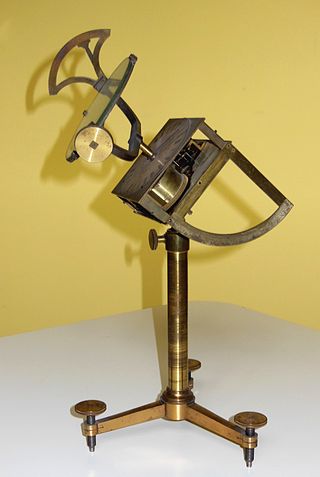
A heliostat is a device that includes a mirror, usually a plane mirror, which turns so as to keep reflecting sunlight toward a predetermined target, compensating for the Sun's apparent motions in the sky.
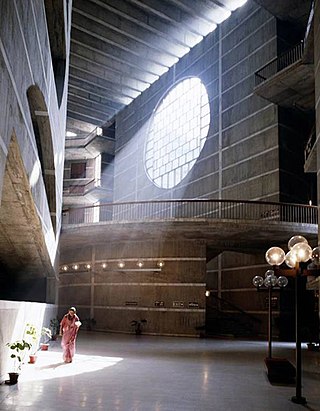
Architectural lighting design is a field of work or study that is concerned with the design of lighting systems within the built environment, both interior and exterior. It can include manipulation and design of both daylight and electric light or both, to serve human needs.

Daylight is the combination of all direct and indirect sunlight during the daytime. This includes direct sunlight, diffuse sky radiation, and (often) both of these reflected by Earth and terrestrial objects, like landforms and buildings. Sunlight scattered or reflected by astronomical objects is generally not considered daylight. Therefore, daylight excludes moonlight, despite it being reflected indirect sunlight.

Sustainable architecture is architecture that seeks to minimize the negative environmental impact of buildings through improved efficiency and moderation in the use of materials, energy, development space and the ecosystem at large. Sustainable architecture uses a conscious approach to energy and ecological conservation in the design of the built environment.
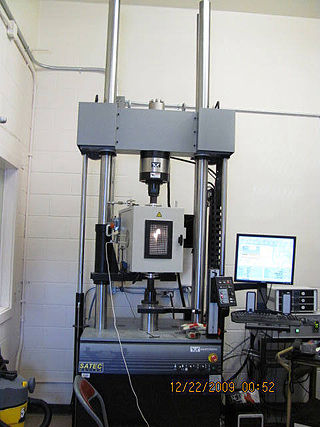
Building science is the science and technology-driven collection of knowledge in order to provide better indoor environmental quality (IEQ), energy-efficient built environments, and occupant comfort and satisfaction. Building physics, architectural science, and applied physics are terms used for the knowledge domain that overlaps with building science. In building science, the methods used in natural and hard sciences are widely applied, which may include controlled and quasi-experiments, randomized control, physical measurements, remote sensing, and simulations. On the other hand, methods from social and soft sciences, such as case study, interviews & focus group, observational method, surveys, and experience sampling, are also widely used in building science to understand occupant satisfaction, comfort, and experiences by acquiring qualitative data. One of the recent trends in building science is a combination of the two different methods. For instance, it is widely known that occupants' thermal sensation and comfort may vary depending on their sex, age, emotion, experiences, etc. even in the same indoor environment. Despite the advancement in data extraction and collection technology in building science, objective measurements alone can hardly represent occupants' state of mind such as comfort and preference. Therefore, researchers are trying to measure both physical contexts and understand human responses to figure out complex interrelationships.
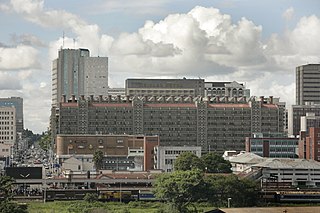
The Eastgate Centre is a shopping centre and office block in central Harare, Zimbabwe, designed by Mick Pearce. Designed to be ventilated and cooled by entirely natural means, it was probably the first building in the world to use natural cooling to this level of sophistication. It opened in 1996 on Robert Mugabe Avenue and Second Street, and provides 5,600 m² of retail space, 26,000 m² of office space and parking for 450 cars.

Light tubes are structures that transmit or distribute natural or artificial light for the purpose of illumination and are examples of optical waveguides.

Sustainable lighting is lighting designed with energy efficient light sources. "There are simple design strategies and some materials that can facilitate the energy saving advantages of natural light. Light colored interiors and open floor plans are good choices. This approach also augments artificial light efficiency. Energy efficient lighting is not simply finding the most light for the least wattage or the longest lasting light bulb. Proper sizing of the light to the needs of the location and the tasks that will be performed, called task lighting, is an energy saving strategy."
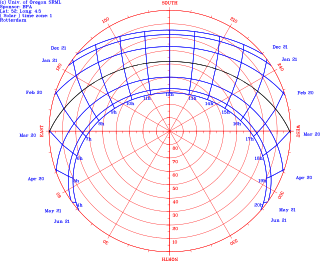
Solar access is the ability of one property to continue to receive sunlight across property lines without obstruction from another’s property. Solar access is calculated using a sun path diagram. Sun is the source of our vision and energy. Its movements inform our perception of time and space. Access to sun is essential to energy conservation and to the quality of our lives.

In architecture, a daylight factor (DF) is the ratio of the light level inside a structure to the light level outside the structure. It is defined as:

A skylight is a light-permitting structure or window, usually made of transparent or translucent glass, that forms all or part of the roof space of a building for daylighting and ventilation purposes.
The following outline is provided as an overview of and topical guide to solar energy:
Photopia Optical Design Software (Photopia) is a commercial optical engineering ray-tracing software program for the design and analysis of non-imaging optical systems. Photopia is written and distributed by LTI Optics, LLC and was first released in 1996. Photopia's main market is the architectural lighting industry but it is also used in the automotive, medical, industrial, signal and consumer products industries. Photopia includes a full library of lamps including the latest high brightness LEDs as well as a library of material BSDF data.
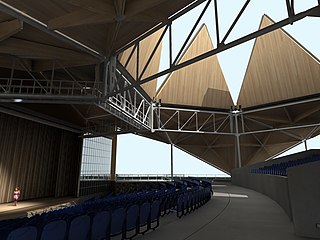
In building engineering, a climate-adaptive building shell (CABS) is a facade or roof that interacts with the variability of its environment in a dynamic way. Conventional structures have static building envelopes and therefore cannot act in response to changing weather conditions and occupant requirements. Well-designed CABS have two main functions: they contribute to energy-saving for heating, cooling, ventilation, and lighting, and they induce a positive impact on the indoor environmental quality of buildings.
The artificial sky is a daylight simulation device that replicates the light coming from the sky dome. An architectural scale model or 1:1 full-scaled aircraft is placed under an artificial sky to predict daylight penetration within buildings or aircraft that subjects to different situations, complex geometries, or heavily obstructed windows. The concept of the artificial sky was derived due to heliodon’s limitation in providing a stable lighting environment for evaluating the diffuse skylight component.
